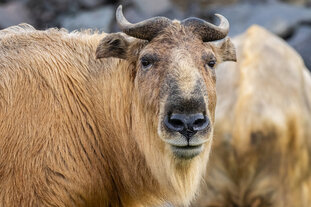Vienna Zoo Builds New Mountain Animal Enclosure

Tiergarten Schönbrunn-Direktor Dr. Hering-Hagenbeck freut sich, Zoobesuchern mit den Goldtakinen künftig eine seltene Tierart präsentieren zu können.
© Foto: Daniel Zupanc
 Die in Zentralchina beheimatete Tierart Goldtakin gilt als gefährdet. Künftig werden Tiere der Spezies im Tiergarten Schönbrunn zu sehen sein. © Foto: Marc Sharping
(eap) A new facility for Asian mountain animals is currently being built on an area of 1,400 square meters in the middle of Vienna‘s Tiergarten Schönbrunn (Vienna Zoo). “We have merged the former enclosures of the Himalayan tarsiers and the maned leaping barbary macaques, which are particularly suitable for mountain animals due to their topography. On the one hand, the Himalayan macaques, which are currently housed in an alternative enclosure, will move back in here. On the other hand, for the first time in the history of the zoo, the rare and very impressive golden takins will also be on display,” reports zoo director Dr Stephan Hering-Hagenbeck.
Die in Zentralchina beheimatete Tierart Goldtakin gilt als gefährdet. Künftig werden Tiere der Spezies im Tiergarten Schönbrunn zu sehen sein. © Foto: Marc Sharping
(eap) A new facility for Asian mountain animals is currently being built on an area of 1,400 square meters in the middle of Vienna‘s Tiergarten Schönbrunn (Vienna Zoo). “We have merged the former enclosures of the Himalayan tarsiers and the maned leaping barbary macaques, which are particularly suitable for mountain animals due to their topography. On the one hand, the Himalayan macaques, which are currently housed in an alternative enclosure, will move back in here. On the other hand, for the first time in the history of the zoo, the rare and very impressive golden takins will also be on display,” reports zoo director Dr Stephan Hering-Hagenbeck.
Both species are native to the Himalayan mountains and are sure-footed even on steep cliffs. Their enclosure in the zoo will be designed accordingly. Over the next few months, natural stones weighing up to six tons will be supplemented with artificial rocks. In total, the facility will have a height difference of twelve meters. Visitors will be able to enjoy a clear view of the animals climbing over a new moat.
The facility is expected to open in August. The tarsiers will move in first – once they have settled in, the new golden takins will follow. Stephan Hering-Hagenbeck is already looking forward to the arrival of the new residents. “With a shoulder height of 1.40 meters, adult golden takins are very impressive. Nevertheless, they are very alert in nature. In their homeland, the mountain forests of the central Chinese province of Shaanxi, they are considered endangered. They are also rare in zoological gardens. In Europe, golden takins are currently only kept in a few zoological gardens.” ■







